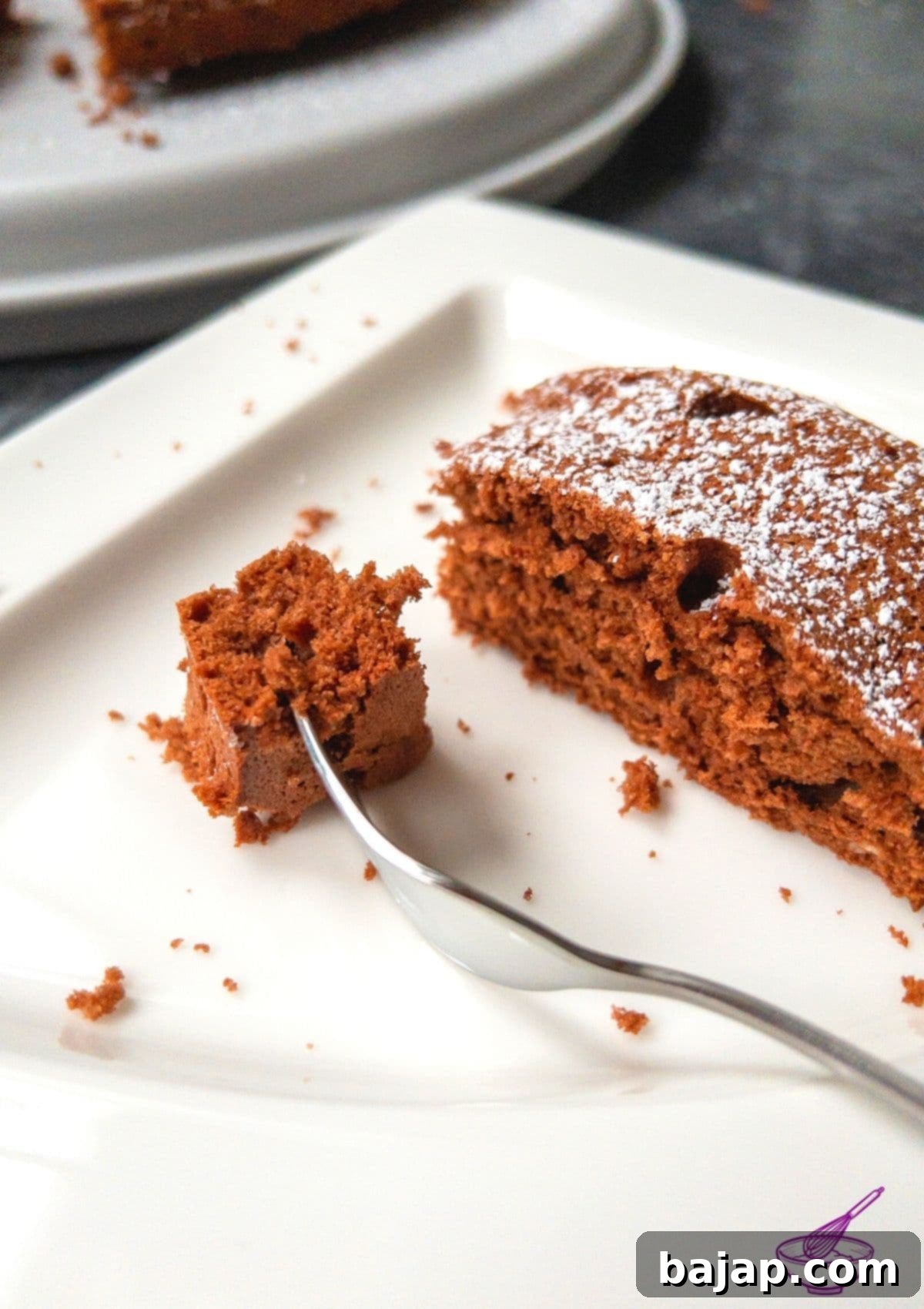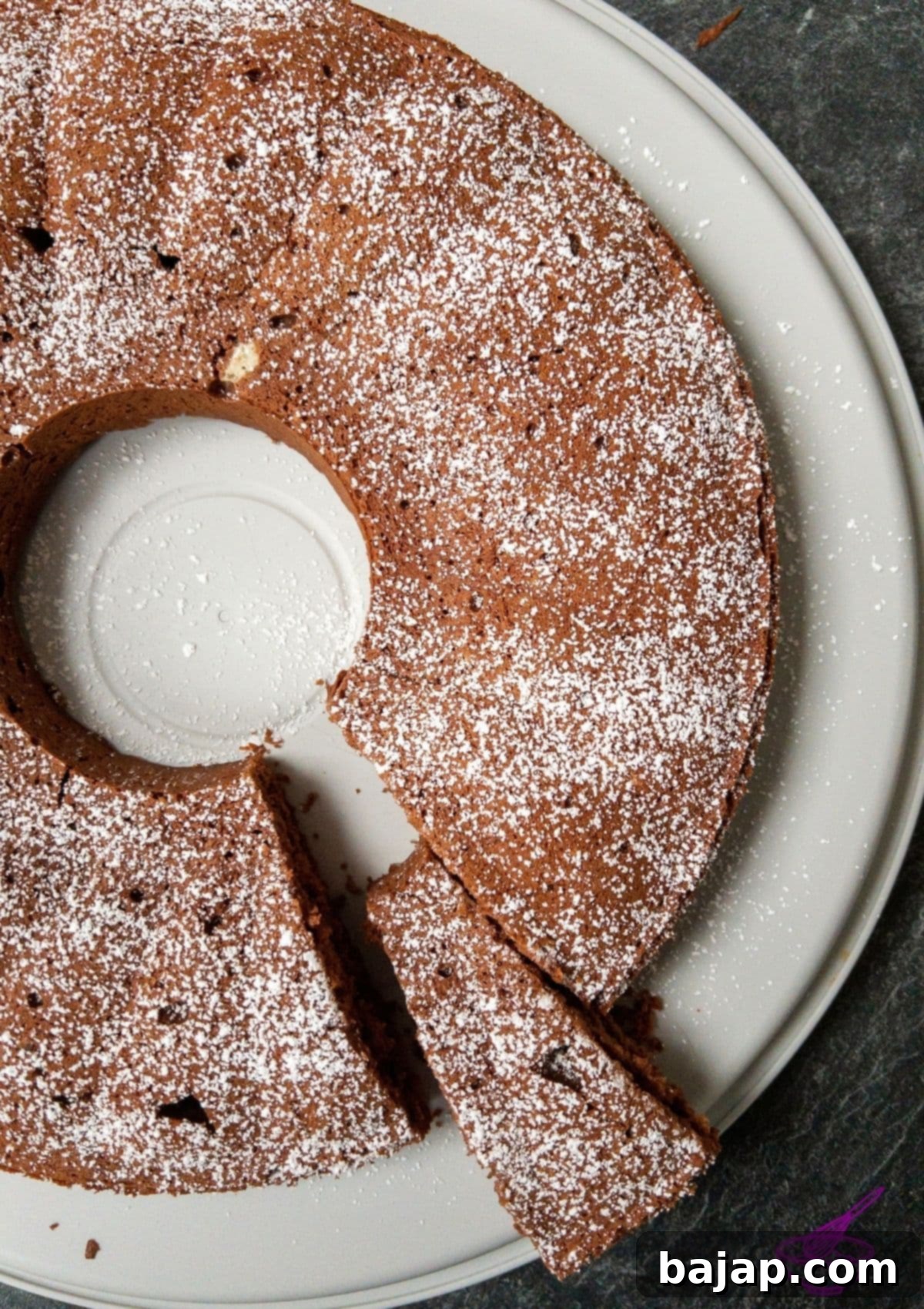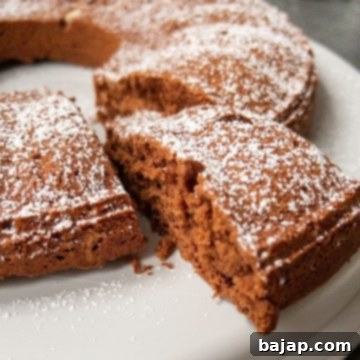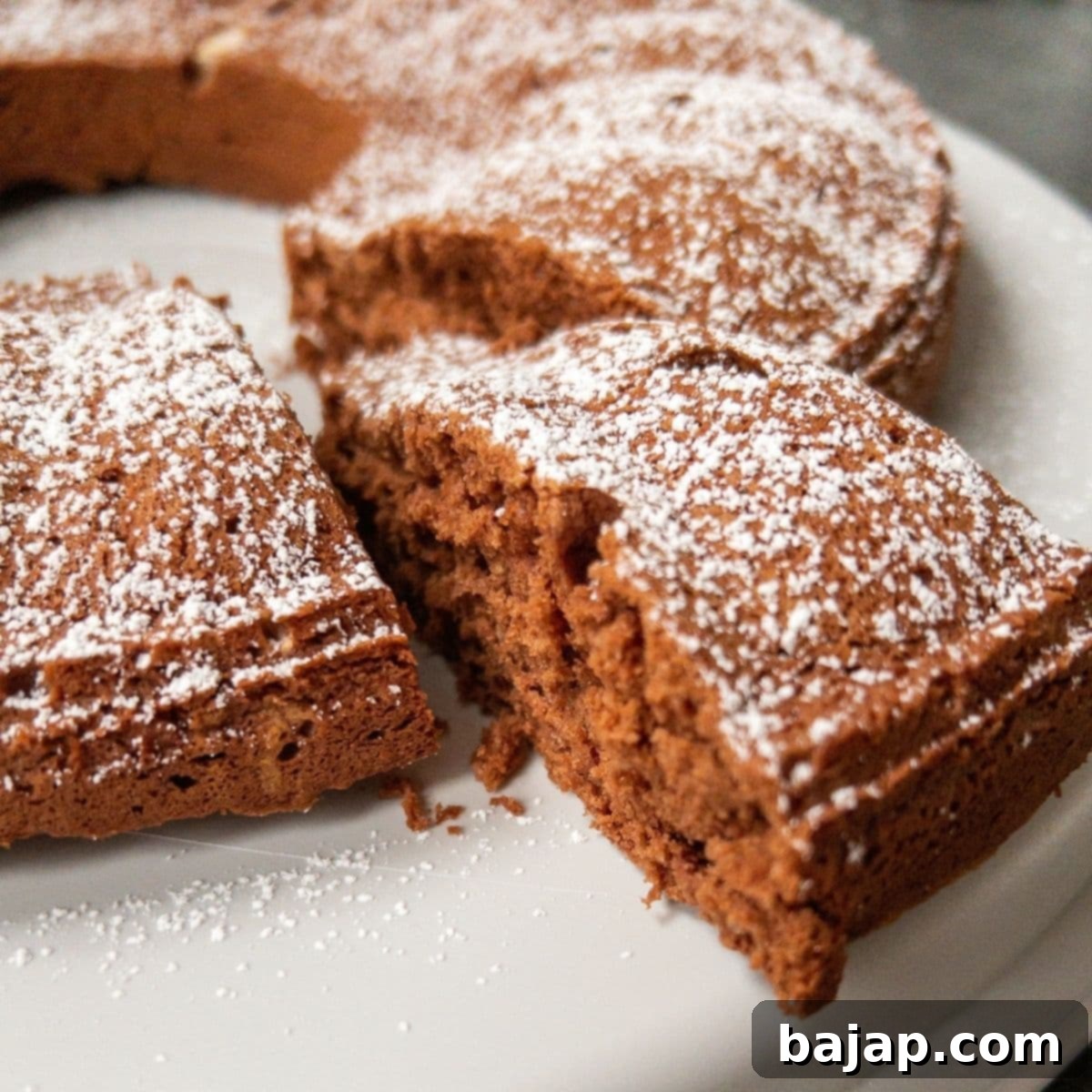Easy & Delicious Chocolate Cake Recipe Using Leftover Egg Whites
Are you often left with a handful of egg whites after making custards, hollandaise, or ice cream? Instead of letting them go to waste, transform them into something truly spectacular! Today, we’re diving into a delightful recipe for a moist and tender chocolate cake, specifically designed to use up those precious leftover egg whites. This recipe is not only incredibly easy to follow but also yields a rich, decadent chocolate cake that’s sure to impress.
This simple yet elegant cake is made with just a few core ingredients: luscious chocolate, fluffy egg whites, creamy butter, fine cake flour, and sweet sugar. Its balanced composition gives it a delightful texture, reminiscent of a classic pound cake, where the careful ratios of butter, flour, sugar, and chocolate create a wonderfully dense yet tender crumb. It’s the perfect way to turn what might seem like a kitchen challenge into a delicious victory.

Many classic recipes specifically call for egg whites, making them a staple in festive baking. For instance, traditional Austrian Christmas favorites like Coconut Busserl cookies and delightful Walnut Meringue Cookies are fantastic ways to utilize those egg whites during the holiday season. So, if you’re planning your Christmas baking and want to incorporate some delicious egg white-based treats, these two cookie recipes are excellent choices to keep in your repertoire. But for a quick, year-round solution to a surplus of egg whites, this chocolate cake stands out as an irresistible option.
Why You Will Love This Egg White Chocolate Cake
This chocolate cake isn’t just a clever way to use up ingredients; it’s a stand-alone star. Here’s why you’ll fall in love with this recipe:
- Effortlessly Elegant: Despite its sophisticated flavor, the preparation is surprisingly straightforward, making it suitable for bakers of all skill levels.
- Perfectly Moist Texture: The egg whites contribute to an incredibly tender and moist crumb, ensuring every bite is rich and satisfying without being heavy.
- Rich Chocolate Flavor: We use dark chocolate couverture, which melts beautifully and infuses the cake with deep, complex chocolate notes that aren’t overly sweet.
- Ingredient Efficiency: It’s the ultimate solution for those lonely egg whites sitting in your fridge, transforming them into a delightful dessert.
- Versatile Serving: Enjoy it plain with a dusting of powdered sugar, or dress it up with whipped cream, berries, or a scoop of ice cream.
🥘 Ingredients: What You’ll Need & Why
Every ingredient plays a crucial role in creating the perfect texture and flavor for this leftover egg white chocolate cake. Here’s a closer look at what goes into this delicious treat and why:
- Cake Flour: This is key for a tender, fine-crumbed cake. Cake flour has a lower protein content than all-purpose flour, which means less gluten development. If you don’t have cake flour, you can make a substitute by measuring 1 cup of all-purpose flour, removing 2 tablespoons, and replacing them with 2 tablespoons of cornstarch (then sift together).
- Unsalted Butter: Using unsalted butter allows you to control the amount of salt in the recipe. Quality butter enhances the richness and moisture of the cake. Ensure it’s at room temperature (if not melting with chocolate) for best emulsification.
- Sugar: Granulated sugar not only sweetens the cake but also contributes to its structure and helps keep it moist. When whipped with egg whites, it creates a stable meringue that provides lift.
- Dark Chocolate Couverture: Couverture chocolate is high-quality chocolate with a higher percentage of cocoa butter, which makes it melt smoothly and gives the cake an incredibly rich, luxurious chocolate flavor. Aim for a dark chocolate with at least 70% cocoa solids for a deep, intense taste.
- Egg Whites: The star of the show! Six egg whites provide the essential structure and light, airy texture that characterizes this cake. When whipped to stiff peaks, they create a stable foam that incorporates air into the batter, resulting in a wonderfully moist and tender crumb.
- Butter or Baking Spray: Essential for greasing your cake pan, ensuring the cake doesn’t stick and releases cleanly after baking.
- Flour or Breadcrumbs: Used for dusting the greased pan. This creates a non-stick layer and helps the cake develop a nice crust. For chocolate cakes, cocoa powder can also be used for dusting to prevent a white flour coating on the finished product.
- Powdered Sugar: For a simple, elegant finish. A light dusting before serving adds a touch of sweetness and a beautiful presentation.
For precise quantities, please refer to the detailed recipe card below.
🍽 Equipment: Tools for Success
Having the right tools on hand makes the baking process much smoother. Here’s what you’ll need to create this fantastic chocolate cake:
- Mixing Bowls: You’ll need at least two – one for whipping egg whites and another for combining melted chocolate and butter. Glass or metal bowls are ideal for egg whites as plastic can retain grease.
- Bundt Cake Pan or Springform Pan: A bundt pan provides a beautiful, decorative shape, while a springform pan makes unmolding a breeze. An 8-inch pan is ideal for this recipe to achieve a good height.
- Rubber Spatula: Essential for gently folding ingredients, especially the delicate egg whites, without deflating them.
- Cooling Rack: Allows air to circulate around the cake as it cools, preventing the bottom from becoming soggy and ensuring even cooling.
- Close-Meshed Sieve: Used for sifting flour and powdered sugar, ensuring a lump-free batter and a smooth finish.
- Hand Mixer or Stand Mixer: While not listed in the original, a mixer is highly recommended for efficiently beating the egg whites to stiff peaks, which is crucial for this cake’s texture.
🔪 Instructions: Your Guide to a Flawless Chocolate Cake

Let’s get baking! Follow these detailed steps to create your delicious chocolate cake:
- Preheat Oven & Prepare Chocolate: Begin by preheating your oven to 180 °C (356 °F). This ensures the oven is at the correct temperature when the cake is ready to bake, leading to even rising and a proper crumb. While the oven warms up, prepare your chocolate.
- Melt Chocolate and Butter: Combine the dark chocolate couverture and unsalted butter in a small pot. Place this pot over a larger pot of simmering water to create a water bath (double boiler). The key here is gentle heat. While the tempering of chocolate for pralines is very precise, for a cake, simply melt it slowly, stirring occasionally, until smooth and fully combined.
- Temperature Control is Crucial: Be very careful not to let the temperature of the chocolate mixture rise above 176 °F (about 80 °C). Excessive heat can “burn” the chocolate, making it seize or become grainy, which will negatively impact the cake’s texture and flavor. The gentle steam from the water bath provides indirect heat, preventing this from happening. Ensure the bottom of the smaller pot does not touch the simmering water.
- Whip Egg Whites to Stiff Peaks: In a clean, medium-sized mixing bowl, place the six egg whites and the sugar. Using a hand mixer or stand mixer, beat them on medium-high speed until they form stiff, glossy peaks. Stiff peaks mean that when you lift the beaters, the egg white mixture holds its shape firmly. Be careful not to overbeat, as this can make the meringue dry and difficult to fold.
- Gently Fold in Flour: Once your egg whites are stiff, sift the cake flour through a close-meshed sieve directly over the beaten egg whites. This step is vital for preventing lumps and ensuring the flour is evenly distributed. Using a rubber spatula, gently fold the flour into the egg whites. Use a light hand and a circular motion, scraping from the bottom up, to incorporate the flour without deflating the airy egg whites. This preserves the volume and lightness of your cake.
- Incorporate Chocolate Mixture: Finally, carefully fold the melted butter-chocolate mixture into the egg white and flour mixture. Again, use a gentle hand and folding technique to maintain as much air as possible in the batter. Mix just until no streaks of chocolate or egg white are visible – overmixing will lead to a dense cake.
- Prepare and Fill Your Pan: Before pouring in the batter, grease your springform or bundt pan thoroughly with butter or baking spray. Then, lightly dust it with flour or breadcrumbs (or cocoa powder for an invisible finish), tapping out any excess. This ensures your cake won’t stick. Now, gently fill the prepared pan with the chocolate cake batter.
- Pan Size Matters: As you might notice, if your pan is a bit too large for this amount of batter, your cake may come out a little flatter than anticipated. While a slightly flatter cake is still incredibly moist and delicious (not crumbly or dry!), if you desire a taller, more impressive cake, I highly recommend using a smaller pan, ideally an 8-inch (20 cm) pan. This will give your cake a more substantial height.
- Bake to Perfection: Place the cake on the middle shelf of your preheated oven and bake for 25-30 minutes. Baking time can vary slightly depending on your oven, so keep an eye on it.
- Test for Doneness: To ensure the cake is thoroughly baked, perform the classic wooden pick test at the end of the baking time.
- Insert a clean wooden pick (like a toothpick or skewer) into the center of the cake.
- Carefully pull the pick out.
- If the pick comes out clean with no wet batter clinging to it, your cake is ready! If there’s still wet batter, bake for a few more minutes and test again.
- Cooling and Unmolding: Once baked, remove the cake from the oven and let it cool in the pan on a cooling rack for about 10-15 minutes. This allows the cake to set. After this initial cooling, carefully open the springform pan (or invert a bundt cake onto the rack) and let the cake cool completely on the cooling rack. Once fully cooled, transfer it to a cake plate.
- Finishing Touch & Serving: Before slicing, generously dust the entire cake with powdered sugar using your fine-meshed sieve. This adds a beautiful, snowy effect and a hint of extra sweetness. Serve it as is for a simple indulgence, or elevate it with a dollop of freshly whipped cream, a scoop of vanilla bean ice cream, or some fresh berries. An eggnog coffee makes a delightful pairing!
🍫 What Kind of Chocolate to Use for the Best Flavor?
The quality of your chocolate can significantly impact the final taste of your cake. For this particular recipe, I personally prefer to use Felchlin’s Centenario Concha 70%. This exquisite couverture is a masterful blend of fine cocoa beans from Bolivia, Ecuador, and Venezuela, resulting in a chocolate with complex flavor notes and an incredibly smooth melt. Working with high-quality chocolate like Felchlin truly elevates the dessert from good to exceptional, and I love sharing this secret with my readers!
If you’re eager to try Felchlin chocolate for yourself, I highly recommend checking out primechocolate.com. As a special treat, you can use the coupon code ThankYouNora at checkout to receive 10% off your purchase. However, please remember that the most important thing is to use a chocolate you genuinely enjoy. Whether it’s a gourmet couverture or your favorite supermarket baking bar, choose a dark chocolate that you love to eat on its own, and it will undoubtedly make your cake taste fantastic.
🥜 Make it Gluten-Free!
Transforming this delicious chocolate cake into a gluten-free delight is entirely possible with a few simple adjustments. For a successful gluten-free cake, it’s generally best to use a blend of gluten-free flours, starches, and a binder to mimic the structure and texture that wheat flour provides. A good rule of thumb is to replace wheat flour with 2 parts gluten-free flour plus 1 part gluten-free starch flour and 1 binder.
Recommended Gluten-Free Flours: Consider using flours like buckwheat, amaranth, millet, quinoa, almond, soy, or chickpea flour. Each offers unique flavor profiles and textures, so experimenting with a blend can yield excellent results. For example, a combination of almond and rice flour often works well for cakes.
Essential Starch Flours: Starch flours are crucial for lightness and a tender crumb. Popular choices include potato starch, rice flour (fine or sweet), cornstarch, or tapioca flour. These help achieve a desirable texture, preventing the cake from becoming too dense.
Crucial Binders: Binders are vital in gluten-free baking to provide structure and prevent crumbling. Great natural binders include chia seeds (ground and soaked to form a gel), ground flax seeds (similarly prepared), psyllium husk powder, locust bean gum, guar gum, or agar-agar. If not opting for vegan, additional eggs or gelatin can also serve as binders. Start with a small amount of binder (e.g., 1 teaspoon per cup of flour blend) and adjust as needed. The key is to find a balance that gives your cake structure without making it gummy.
When baking gluten-free, remember that the batter might have a slightly different consistency, and baking times can vary. Always trust the wooden pick test for doneness!
🌡️ Storage Tips for Freshness
Ensuring your chocolate cake stays fresh and delicious is simple with these storage guidelines:
Room Temperature: This chocolate cake will remain wonderfully moist and flavorful for about five days when stored under a cake dome or in an airtight container. Keep it in a cool, dry place away from direct sunlight.
Freezing for Later: This cake freezes beautifully! Once the cake has completely cooled to room temperature, wrap it tightly in several layers of plastic cling film, then an additional layer of aluminum foil. This double-layer protection helps prevent freezer burn. Label with the date and freeze for up to 2-3 months. To enjoy, thaw the cake overnight in the refrigerator, then bring it to room temperature before serving for the best texture and flavor.
💭 Top Tip: Scaling Your Egg White Cake
One of the best features of this recipe is its incredible flexibility and ease of adjustment to the amount of leftover egg whites you have. It follows a simple, proportional rule:
For every single egg white (approximately 0.7 oz or 20 g), you will need 0.7 oz (20 g) of each of the remaining core ingredients: butter, flour, sugar, and chocolate.
This means you can easily scale the recipe up or down. For example, if you find yourself with a surplus of four egg whites instead of six, you can still bake a perfectly balanced chocolate cake! You would simply use 2.8 oz (80 g) of butter, 2.8 oz (80 g) of flour, 2.8 oz (80 g) of sugar, and 2.8 oz (80 g) of chocolate. This makes it a fantastic adaptable recipe, ensuring no egg white ever goes to waste!
More delicious cake recipes for you to try:
- Flourless Chocolate Cake
- Chestnut Cake
- Austrian Strawberry Sponge Cake
- Potato Flour Cake with Eggnog
- Whipping Cream Bundt Cake
- Chocolate Chip Ricotta Loaf Cake
- Double Chocolate Bundt Cake
If you make this recipe, let me know how you liked it by ★★★★★ star rating it and leaving a comment below. This would be awesome! You can also sign up for our Newsletter or follow me on Pinterest or Instagram and share your creation with me. Just tag me @combinegoodflavors and hashtag #combinegoodflavors, so I don’t miss it.
📖 Recipe Card: Six Egg White Chocolate Cake

Six Egg White Chocolate Cake
By Nora
Pin Recipe
30 minutes
30 minutes
1 hour
Cake, Dessert
European
16 Slices
160 kcal
Equipment
-
Mixing bowls
-
Spring bundt pan
-
Rubber spatula
-
Cake rack
-
Close meshed sieve
-
Hand Mixer or Stand Mixer
Ingredients
- 6 Large Egg whites
- ½ cup Granulated Sugar
- ¾ cup Dark Chocolate couverture
- 1 cup Cake Flour
- 8 ½ tablespoons Unsalted Butter
- butter or baking spray for coating the pan
- flour or breadcrumbs for dusting the pan
- powdered sugar for dusting the cake
Instructions
-
Preheat your oven to 180 °C // 356 °F.
-
Combine the dark chocolate couverture and unsalted butter in a small heatproof pot. Melt them gently in a water bath (double boiler), stirring until completely smooth. Ensure the chocolate’s temperature does not exceed 176 °F (80 °C).¾ cup Dark Chocolate couverture, 8 ½ tablespoons Unsalted Butter
-
In a separate, clean medium bowl, place the six egg whites and the granulated sugar. Beat them with a mixer until they form stiff, glossy peaks.6 Egg whites, ½ cup Sugar
-
Sift the cake flour through a close-meshed sieve directly over the stiffly beaten egg whites. Gently fold the flour into the egg whites using a rubber spatula to maintain the air.1 cup Cake Flour
-
Carefully fold the melted butter-chocolate mixture into the batter until just combined, being careful not to deflate the egg whites.
-
Grease your springform or bundt pan thoroughly with butter or baking spray and dust it with flour or breadcrumbs (or cocoa powder). Pour the cake batter into the prepared pan.butter or baking spray, flour or breadcrumbs
-
Bake the cake for 25-30 minutes in the preheated oven on the middle shelf.
-
Test for doneness with a wooden pick. If it comes out clean, the cake is ready. Remove from oven and let it cool in the pan on a cooling rack for 10-15 minutes.
-
Once cooled slightly, open the springform pan and transfer the cake to a cooling rack to cool completely. Once fully cooled, place it on a cake plate.
-
Before serving, generously dust the entire cake with powdered sugar using a fine-meshed sieve for a beautiful finish.powdered sugar
6 egg white cake recipe, cake recipe, chocolate cake, chocolate egg white cake recipe, whipped egg white cake recipe, leftover egg whites dessert
Nutrition values are estimates only, using online calculators. Please verify using your own data.

🍰 You Might Also Like These Recipes
- Fresh Strawberry Sponge Cake
- Potato Flour Cake with Eggnog
- The Ultimate Double Chocolate Bundt Cake
- Chocolate Chip Ricotta Loaf Cake
⛑️ Food Safety: Important Reminders for Home Bakers
Ensuring food safety in your kitchen is paramount, especially when working with ingredients like eggs. Please keep these essential food safety guidelines in mind to protect yourself and your loved ones:
- Cook all food, especially egg-containing dishes, to a minimum safe internal temperature of 165 °F (74 °C).
- Always use separate utensils for raw ingredients and cooked food to prevent cross-contamination.
- Wash your hands thoroughly with soap and warm water after handling raw eggs or any raw meat products.
- Avoid leaving cooked food sitting out at room temperature for extended periods; refrigerate promptly.
- Never leave cooking food unattended, particularly when using heat-intensive methods.
- When cooking at high temperatures, use oils with a high smoking point to avoid the formation of harmful compounds.
- Always ensure good ventilation in your kitchen, especially when using a gas stove, to prevent the buildup of fumes.
For further comprehensive information on safe food handling practices, please refer to the official guidelines from the FDA (Food and Drug Administration).
